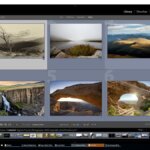Too many photography tutorials only discuss aperture as the method a photographer uses to control depth of field. In fact there are four factors that control depth of field and using them together gives you far more options and capabilities than aperture alone. Without understanding how all four factors combine you will always run into issues getting your depth of field (DOF) the way you want it.
So first let’s start with “What is Depth of Field (DOF)?” It is generally described as the range of distances in a photo within which the image appears sharp. (standards for “sharp” will vary with measuring criteria and will change based on print size, viewing distance and viewer’s vision acuity). Below are two example images. One with a large (deep) depth of field and the other with a small (shallow) depth of field. Keep in mind that these are relative terms. “Deep” in a landscape is not the same thing as “deep” in a macro photo. An acceptably deep DOF in a landscape might be a distance of miles while within a macro flower photograph an acceptably deep DOF may only be centimeters.


Factors that will affect your DOF results:

Creative Commons Use – Diagram by Xiuchai Xu http://xiuchaixu.com/depth_of_field.htm
- Aperture: (the opening controlling the amount of light passing through the lens)
- The larger your f-stop the smaller your aperture and vice verse.
- If you find this difficult to remember. Pretend the the f-stop numbers are fractions(ie: f/2 is larger than f/16)
- The smaller your aperture > The larger your depth of field.
- The larger your aperture > The more shallow your depth of field.
- Distance to Subject:
- The farther your subject (ie: focus point) > The larger your depth of field.
- The closer your subject (ie: focus point) > The more shallow your depth of field.
- Focal Length:
- The smaller your focal length (decreased zoom) > The larger your depth of field.
- The larger your focal length (increased zoom) > The more shallow your depth of field.
- Note: increased focal length (while changing your position such that the subject size within your frame stays the same), does not actually change DOF, but it will appear to reduce DOF. This is caused by magnification of the circles of confusion (ie: background Bokeh “the blur”).
- Sensor Size:
- The smaller your camera’s sensor size > The larger your depth of field.
- The larger your camera’s sensor size >The more shallow your depth of field.
- All things the same (distance, aperture, focal length) a full frame sensor camera will have a more shallow depth of field than will a APS-C camera, than will a 4/3 camera, than will a pocket or phone camera.
Additional Depth of Field Notes:
- If you view the diagram above you’ll notice that depth of field increases approximately twice as far behind the point of focus as it does in front of point of focus (focal point).
- When using a pocket/phone camera (see “sensor” above) you will rarely ever see a shallow depth of field. Only under extreme condition (like being very close to subject)
- The “blur” you see in an image with shallow depth of field is called Bokeh.
- The shape and texture of bokeh is directly related to the shape of the aperture blades within your lens.
In Depth Information: This depth of field tutorial is part one (the “basics”). The upcoming “advanced” articles will delve into the science of depth of field. So if you want to learn how and why the above rules occur, stay tuned via FB, Twitter, Google+ or RSS.















